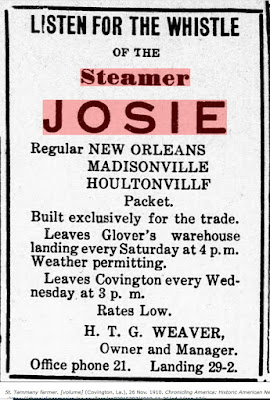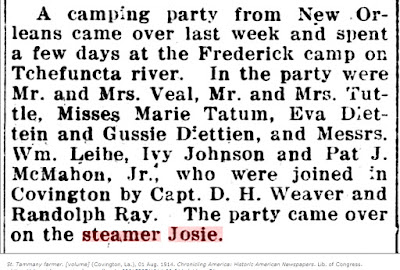Before the steamboat era, a number of sailing schooners served Covington and all points on the Tchefuncte River, hauling freight and bringing passenger to and from New Orleans. Prior to 1908, one of the
main ways to get people and cargo to New Orleans was by sailing schooner.
Among the schooners there was the sailing Schooner Josie Weaver. Click on the images to make them larger.
In the history book "St. Tammany Parish - L'Autre Cote' du Lac," by Frederick S. Ellis, he notes that the sailing schooner Josie Weaver, in one week in the late 1800's, carried 52 bales of cotton, 126 barrels of rosin, six barrels of turpentine, 250 barrels of sand, and 25 barrels of clay to New Orleans.
The Steamer Comes To Covington
In April 1908 The Steamer Josie was launched
All the cotton had previously been shipped on schooners, but when the Josie was built, it was for freight. It would occasionally take a few passengers. Click on the images to make them larger.
The boat was 100 feet long and 24 feet wide, weighing 50 tons.
In this picture, probably taken around 1909, the King of Carnival arrived via the steamer Josie to Covington.
Mrs. Weaver, wife
of the captain of the steamer Josie, would take a group of boys and
girls down on the steamer to go swimming in the lake at a spot beyond
Madisonville by the lighthouse. People living in Covington would listen for its whistle to know it had arrived with packages and mail.
The Josie at the Columbia Landing dock
The Josie was also used for special excursion events. On May 27, 1922, a special weekend was planned and according to news items of the time: "There will be music aboard
with swimming in Lake Pontchartrain, to be the chief attraction. A big
dance will follow in the Riverside Pavilion at 8:30."
Keeping the Bogue Falaya dredged out became a problem.
The Steamer Josie with (sitting) Henry Weaver; Backrow: Unknown, unknown, Norma Weaver, Josie Weaver and Dudley Weaver. Photo source: Madisonville Historical Group Facebook Page
The boat was not without its mishaps.
In this 1939 topographical map, the "Head of Navigation" for the Bogue Falaya River was shown to be just below where the Chimes Restaurant is today, which was the location of the first St. Tammany Parish courthouse. It is doubtful large boats could have made it that far upriver because of the sand, silt and fallen trees.
Eventually the river narrowed, the sand bars became more and more a hazard to navigation, and the "head of navigation" moved southward towards Menetre Landing. The active Columbia Landing port of Covington diminished in importance and trade. The trains and the trucks had taken their toll.
In 2010 the late Rusty Burns wrote on Facebook: "Amazing the changes in river
depth. Ever since Jahncke quit dredging, shoaling has brought the depth
at Columbia landing to 1 foot. Any vessel with a draft of 4 feet cannot
navigate above the convergence of the Abita River.
"When I was a
kid, Columbia Landing was at least 6 foot deep. We could run an
inboard boat from Madisonville to Columbia Street with (no) concerns of
adequate depth. Obstructions; yes, depth, no. There were shoals, near
the park, but easily navigated.
" It is my
belief that the "Josie" is sunk in the ship graveyard north of
Madisonville south of the Hilda Blanc and Josephine Mesjay," Burns said.
Also according to Burns, the home of Captain Weaver was a place called "Riverside Inn" on the Bogue Falaya River. The property was also known as
"Favrotville". Dudley Weaver was the captain of the M/V Josie and
also worked with the "New Camelia."
For a PDF File of this blog article, CLICK HERE.
See also:


















































